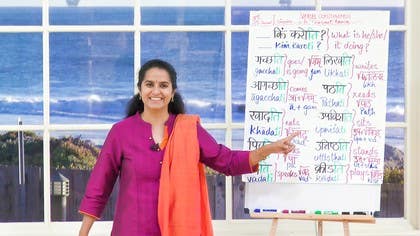Description
About This Video
Transcript
Read Full Transcript
Welcome Sanskrit lovers. We are getting ahead with the language and we have learnt the nouns. We have learnt a few pronouns. The next part of it when we are trying to make sentences is to add a verb because nouns have to do things. But looking at the way the verb is conjugated we get an idea of who is doing it, when are they doing it and how they are doing it sometimes. So every verb has these different aspects or this different information that it conveys to us. The way in which a verb is conjugated gives us all this information who is doing it and when they are doing it and how many of them are doing it. Right? So now looking at the different verbs that we have in the Sanskrit language what I will invite you to do is first just dive into the language. We will try and do this real time. Try and feel what the word sounds like. The easiest way of getting Sanskrit is to really sound the language. The more you sound it the more easily apparent the grammar of the language becomes. Alright? So you will hear the logic of the word. So what we will do right now is we will do the third person singular in the present tense and see how the verb is conjugated. Don't worry about the verb root at this point. Just follow along. What I propose to give you now is the software of the language. You know how to use it. Later on when we have more time together we will delve deeper into the roots. Stay with me and it will get clearer for you. I have lovely Alana with me to the studio today. So Alana thank you for being here. She is going to be the model demonstrating the third person verbs. So let's go for it. Yeah? You ready? So Alana goes. Goes. Gachati. Gachati. Say that. Gachati. We did the pronouns as well. So Alana being a lady singular and going away would be sa gachati. Sa gachati. The beauty in Sanskrit is that even if you have just the verb gachati, the very fact that you have said a t means that it is the third person who is going. A single person in the present tense is going. Gachati. Comes. A gachati. A gachati. Comes. A gachati. If you want to be more specific, Alana a gachati. If you want to just use a pronoun. Sa a gachati. Got that? The prefix a makes the action towards you. So a gachati. Goes gachati and comes. A gachati. Lovely. Next eats. Imagine you're having a very tasty meal out there. So eats. Kaddati. Kaddati. That's a lot of food. Okay.
So Kaddati. So Alana Kaddati. Sa or Esha because she's right next to me now. Esha Kaddati. But a beautiful thing about the language at this part is that it doesn't matter who is doing it. Just like in English you can say he goes, she goes. The gender doesn't really matter. So you can say sa gachati or if it's a man sa gachati. Alright. So gachati by itself is good. If you want to be more specific you add a pronoun masculine or feminine. That doesn't affect the form of the verb. So once more to eat. Alana eats. Kaddati. Drinks. She'll need a lot of water after that or a lot of juice after that. Pibbati. Pibbati. Say that. Very good. Pibbati. Drinks. Great. Next. What's your name? Vaddati. Alana speaks. Vaddati. Alana Vaddati. At this point I will introduce the question what is Alana doing?
Alana kim karoti. Kim is what? So kim karoti and if Alana is speaking Vaddati. Vaddati. So one other point here is that the verb goes and the present continuous form is going is represented by the same conjugation. So Vaddati can mean speaks. It can also mean is speaking. Alana is speaking. Vaddati. Very nice. Next. Writes. Write Sanskrit maybe. Writes. Likhati. Remember we saw the word for a pen which was Lekhani and now when she writes it is Likhati. Can you recognize the two sounds in there? Lekhani and Likhati. Well it's at that point that we can start getting a feel of what the root might be like. The root in this case is Lik. Lik. And that becomes Likhati. Writes. To write a lot you have to start reading also quite a bit you know. Pathati. Alana Pathati. Say that. Very good. Now if you could please sit down. She has been standing and doing a lot of hard work. So Upavishati. You can almost feel the person settling down. Upavishati. Say that. Fantastic. We will make her get up now. So stands Uttishthati. Do that. Uttishthati. Alana Uttishthati. Lovely. We will sit again.
So Upavishati. Perfect. And Uttishthati. You can almost feel the ut to stand up right. And Uttishthati. And another verb which is used quite often and fun is to play. But here it's playing a game. So plays. Wow. That's a very good goal. Kri dati. Kri dati. Alana Kri dati. And if you want to say she was playing really well Samyak. Okay. Samyak. Alana Samyak Kri dati. She's playing very well. Great. So we'll just revise the verbs one last time. And if you have noticed the pattern in these verb conjugations. We had gachhati. Aagachhati kar dati. Do you hear it? Yeah. It's the tea. The tea at the end of the word or at the end of the verb gives us the understanding that it is one person, the third person and in the present tense performing the action. So let's review the verbs again in the third person singular. Alana gachhati goes. Gachhati comes. Aagachhati. Aagachhati. Eats. Kah dati. Kah dati drinks. Pibhati. Pibhati speaks. Vadhati. Vadhati writes. Likhati. Likhati reads. Pathati. Pathati sits. Upavishati. Got it? Upavishati stands. Uttishtati. Uttishtati. You see she's got one shot. Utte. And plays. Kri dati. Kri dati. Alright. Lovely. Thank you. That was very nice. So to make your life easier, I'd like to share with you that when we talk about you doing an action, it also has the same form when you use it in the formal way. So if we had to say you as in Bhavati go, it'll be Bhavati gachhati. Bhavati gachhati. And like we saw earlier, it doesn't matter whether it's a man or a woman or any other saying. What counts is the ending of the verb. So gachhati. So it can be saha gachhati, masculine sah gachhati, feminine, tat gachhati in the neuter. And it can also be the formal you which is Bhavan for a man, gachhati and Bhavati for a lady, gachhati. Great. So enjoy doing that. When you see somebody else going, coming, see if the word starts playing in your head.
And then when it starts playing and you read it somewhere, your consciousness will immediately recognize the word there. Practice, enjoy, play with Sanskrit. Thank you very much. Dhan neaya vada.







You need to be a subscriber to post a comment.
Please Log In or Create an Account to start your free trial.